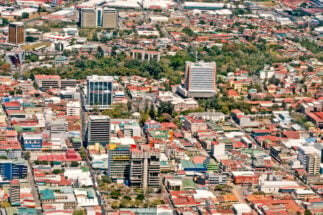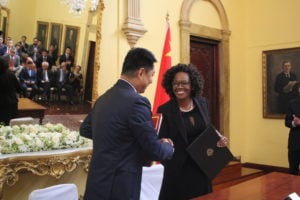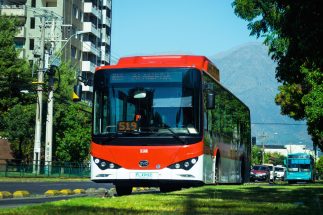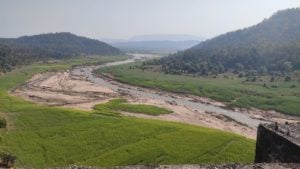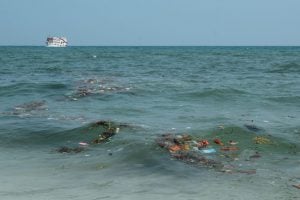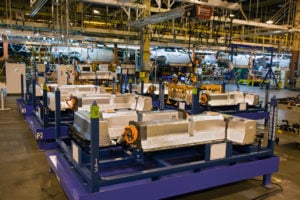Think of Costa Rica and you probably think of verdant rainforest, sweeping sandy beaches and colourful wildlife. Its green reputation is not unjustified: as well as a highly developed ecotourism sector, the country has produced almost 100% of its electricity from renewable sources since 2014.
But the reality for urban-dwelling Costa Ricans is very different. The Central American country is grappling with poorly planned cities, inefficient public transport and an increasing share of vehicles that run on fossil fuels. Half of Costa Rica’s emissions come from the transport sector.
Yet, naturally for a country with strong environmental policies “in its DNA”, according to president Carlos Alvarado, it has a plan.
Indeed, its aim is to completely decarbonise the economy by 2050, as outlined in its climate pledge submitted to the UN in December 2019, an update to its commitment made under the Paris Agreement, called a “Nationally Determined Contribution” (or NDC) in climate circles.
To reach this goal, however, an overhaul of Costa Rica’s transport network will be fundamental. China, which in 2019 recruited Costa Rica to its Belt and Road Initiative (BRI) and has brought down the costs of electric cars, buses and trains worldwide, has a part to play.
Costa Rica’s zero emissions journey
The decarbonisation plan proposes the construction and commissioning of an urban electric train by 2030, as well as the electrification of 8% of buses and cars by the same year. Achieving this and the 2050 target will depend on political commitment, as well as GDP growth and electricity prices, said Felipe de León, an advisor to Costa Rica’s Directorate of Climate Change at the Ministry of the Environment.
The price of electric vehicles (EVs) is one of the most important variables in climate models, De León said. By the time the country recovers from the Covid-19 crisis, EVs should be affordable for middle-class Costa Ricans.
China has made EV ownership cheaper though mass production, De León said, and although the two countries have yet to establish any formal agreement on meeting climate goals, its promotion of electric transportation and renewable energy will have an impact on Costa Rican capital San José, more than 14,000 kilometres away.
“Having access to electric buses at a competitive price, for example, is something potentially transformative for countries like Costa Rica,” said De León.
Costa Rica also joined China’s Belt and Road Initiative in 2019, anticipating investments in road and rail connectivity, Costa Rica’s vice president Epsy Campbell said. China even offered cooperation on a “green recovery” to the Covid-19 pandemic.
China, through its decisions on sustainability, could make sustainability easier for everyone
Still, Costa Rica’s transport issues are a symptom of the bigger problem of unplanned cities, said Andrea San Gil, an environmental engineer and founder of the Center for Urban Sustainability.
Beyond cleaning its roads, Costa Rica must clean its urban area, San Gil said. This could go hand in hand with housing reforms that focus on creating a better connected city.
Between now and 2030, however, the country will only be able to emit, on average, 10 million tons of CO2 equivalent per year in order to honour its Paris commitments. By way of comparison, this is a third of what the US’ United Airlines emitted in 2019.
If Costa Rica can meet its emissions “budget”, it could bring US$41 billion in benefits, according to a recent study by the Inter-American Development Bank (IDB).
“For Costa Rica it is a matter of competitiveness,” De León concluded.
Rethinking Costa Rica’s cities
In contrast to its many immaculate and world famous tourist destinations, the cities of Costa Rica are veritable “concrete jungles” characterised by disorderly growth, according to San Gil.
Since the 1980s, the Greater Metropolitan Area (GAM) in the central valley has grown with little planning. Although it has doubled in size in the last 30 years, as of 2019, 40% of its cantons still did not have a regulatory plan.
Instead of growing around existing public transport networks, San José expanded to places with little connection, where private cars are the only option, San Gil said. This is not compatible with decarbonisation, she added.
“If new developments are to be made, they must be transport-oriented. The first question we must ask ourselves is; how are people going to get here?”
Compact cities are a linchpin of Costa Rica’s NDC. By 2030, the country would seek to incorporate “transportation-oriented development criteria” into its Urban Development Plan.
The change, however, will be complex, according to San Gil. She said the government has talked about the electrification of transportation, but not enough about sustainable cities. “Electrification is essential but it is not the priority. It’s sexy because it maintains the development model, but it’s inefficient.”
5%
of urban journeys in Costa Rica will non-motorised by 2030, if government targets are met
Costa Rica also aims to have all 5% of all urban journeys to be made by non-motorised transport by 2030. These could be by bicycle, or simply on foot, according to the updated NDC.
But the country still has little urban transport infrastructure. It has no network of bicycle lanes, only isolated routes.Furthermore, urban areas are heating up due to climate change, making active transport unappealing.
Nature can be an important ally, San Gil said, as increasing the natural landscape in cities serves to lower temperatures and encourage outdoor roaming. “If the city doesn’t invite you to walk in a safe and pleasant way, no one will,” she added.
Clean transport
For journeys that must be made on at least four wheels, priority will be public transport and lastly private cars.
Jairo Quirós, an energy expert at the University of Costa Rica (UCR), said electric transport can be especially effective in reducing Costa Rica’s emissions. Unlike other countries, the electricity that powers vehicles already comes from renewable sources.
Costa Rica’s public transport network currently relies on buses. The country began trials with its first three electric versions, manufactured by China’s BYD, this February. They currently operate on real public transportation routes in San José. These trials will provide data so that bus companies can invest in technology with greater assurances.
BYD brand has large fleets in a number of other Latin American cities. Chilean capital Santiago, for example, has 285 of its buses already circulating on its streets.
An electric train network would further serve San Jose and the wider metropolitan area as a hub for public transport that connects with bus routes.
The Central American Bank for Economic Integration (CABEI) approved a loan of US$1.5 billion for the construction of the project. But after criticism from the Legislative Assembly of its high cost, the government put the project on ice.
“We are all clear about what to do. The question is who is going to get the credit. It is unfortunate, but it also gives you certainty that sooner or later it will have to happen,” said De León.
Electric cars
Costa Rica has also taken tentative first steps to electrify its fleet of cars. Since 2018, EVs have been exempt from taxes and the market has grown accordingly.
The country also launched one of the most extensive fast charging networks in Latin America. By law, there must be a recharging centre at maximum intervals of 80km on national routes.
The move began to take shape in 2020, when the Costa Rican Electricity Institute (ICE) installed 28 fast chargers nationwide. For the first time, devices included a connector for Chinese cars, which use GB / T technology, a type of connector issued by the Standardization Administration of China.
It was only a matter of time given China’s dominance in the global EV market. In 2018, China produced more electric cars than the rest of the world combined. “China, through its decisions on sustainability, could make sustainability easier for everyone,” said De León.
Will there be barriers? Yes, and it will probably take up some investments. But we have a net profit cushion of US$41 billion
Costa Rica, however, still has obstacles. Despite being a necessary change, an EV rollout currently stands to hit government coffers, Quirós said.
About 11% of government revenue in 2018 came from fuel taxes. If transport is electrified, that percentage will decrease. With Costa Rica currently running its highest fiscal deficit in history, this is a particularly sensitive subject.
To address this, Costa Rica’s NDC indicates that, by 2030, the country will have implemented “at least one” green tax reform instrument which would compensate for the money lost from taxes on conventional cars. This is also recognised in the country’s Decarbonisation Plan.
In spite of this fiscal impact, other costs could be saved by making transport more efficient. For example, lost productivity and health impacts from the current transport system cost an estimated 3,8% of Costa Rica’s GDP every year.
The country also has to take its electrical generation into account. As the number of EVs increases, more electricity will be needed and it is vital that any new projects are renewable, Quirós explained.
“Solar photovoltaic plants and wind plants are already cheaper than investing in a thermoelectric plant. Investments between now and 2050 are going to be cheaper if they carry on along these lines,” he said.
Costa Rica-China cooperation
With Costa Rica’s path to zero emissions set out, cooperation with international partners such as China can help reach the final destination. Yet, China’s assistance on a “green recovery” for Costa Rica will mean a break from previous joint projects.
In 2008, when countries initiated diplomatic relations, one of the first plans for the partnership on Costa Rican soil was an oil refinery.
The project involved cooperation between the oil institutes of Costa Rica and China, for an initial US$100 million. However, the refinery did not progress after Costa Rica’s National Audit Office questioned feasibility studies because they were carried out by China Huanqiu Contracting & Engineering, a firm linked to the Chinese partner, China National Petroleum Corporation (CNPC), raising concerns of a possible conflict of interests.
Right now, Costa Rica and China have a free trade agreement and an accord to protect investments from each country, according to the Chinese embassy in San José. Costa Rica’s endorsement of the BRI also brings the prospect of a finance for infrastructure and commerce projects, vice president Campbell said on joining the initiative in 2019.
More recently, Chinese cooperation has focused on health and, in the wake of the Covid-19 pandemic, donations of medical supplies for health personnel.
China has also shown interest in new sustainable projects. In a recent call, Chinese minister of foreign affairs Wang Yi told his Costa Rican counterpart, Rodolfo Solano, that he was “committed” to strengthening cooperation on climate change.
With the two countries already agreeing to cooperate under the banner of the BRI, the current juncture could offer a rare chance to rethink cooperation and meet shared climate goals, according to Quirós, who again highlighted the economic benefits that the IDB believes energy saving and improvements in ecosystems and agriculture could bring:
“Will there be barriers? Yes, and it will probably take up some investments. But we have a net profit cushion of US$41 billion.”
